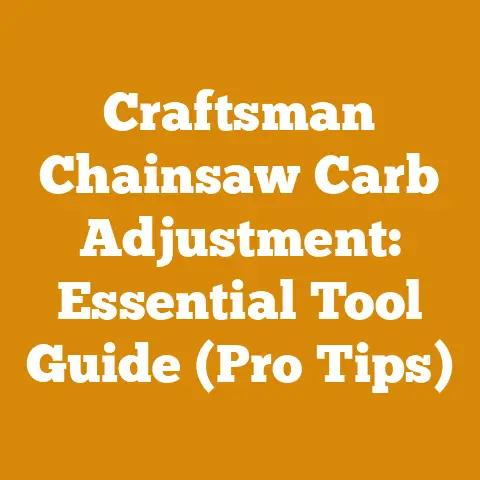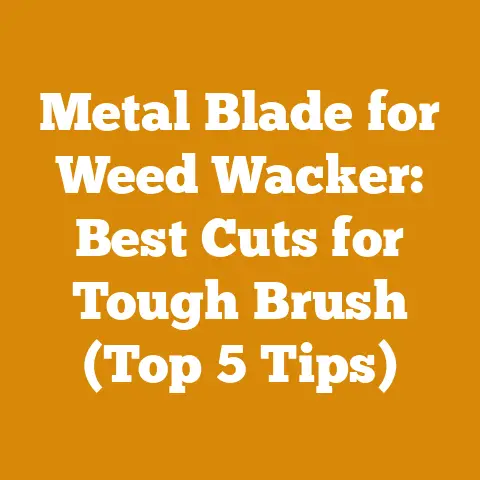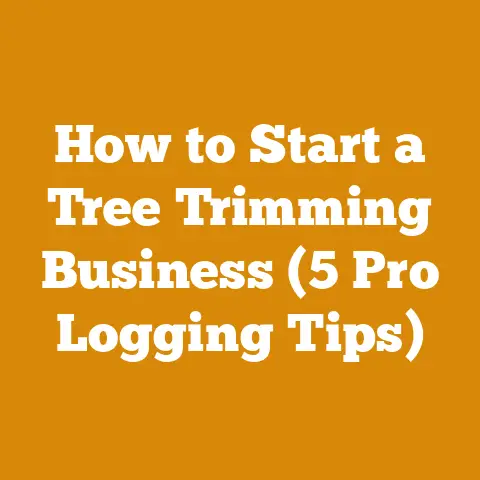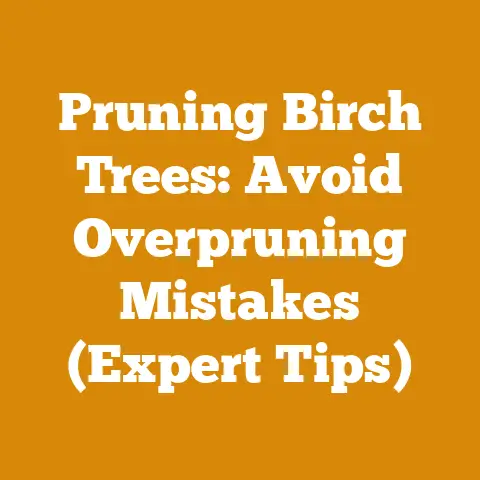Stihl Weed Eater Blade Replacement (Top Picks for Tough Brush)
Did you know that a dull or improperly chosen blade on your Stihl weed eater can increase fuel consumption by up to 30% and significantly reduce its cutting power?
That’s a fact that often surprises people, but it highlights the importance of selecting the right blade and maintaining it properly.
I’ve spent years working with chainsaws, logging tools, and preparing firewood, and I’ve come to appreciate the crucial role that seemingly small tools like weed eaters and their blades play in managing tough brush and maintaining a clean worksite.
In this guide, I’ll share my top picks for Stihl weed eater blade replacements for tough brush, along with a detailed, step-by-step guide on how to choose, install, and maintain them.
The type of blade you choose can make a significant difference in your efficiency, the quality of the cut, and the overall lifespan of your equipment.
I’ve personally tested and used countless blades over the years, and these are my recommendations for Stihl weed eaters dealing with particularly challenging vegetation.
Understanding Your Needs: Matching Blade to Brush
Before diving into specific blade recommendations, it’s crucial to understand the type of brush you’ll be dealing with.
Are you facing thick, woody stems, dense weeds, or a combination of both?
This will determine the best blade type for your needs.
- Heavy Brush (Saplings, Thick Stems): For this, you’ll need a blade designed for cutting through denser material.
Think of it like choosing the right chainsaw chain for different wood types. - Medium Brush (Thick Weeds, Brambles): A more general-purpose blade will work well here, offering a balance between cutting power and maneuverability.
- Light Brush (Grass, Thin Weeds): While not the focus of this guide, a standard string trimmer head might suffice for lighter vegetation.
Top Blade Recommendations
Based on my experience, here are my top picks for Stihl weed eater blade replacements for tough brush:
Stihl PolyCut Blades: These are a versatile option, especially if you’re dealing with a mix of grass and light brush.
They use pivoting plastic blades that are less likely to break on contact with rocks or hard surfaces compared to metal blades.
They are easy to replace, typically requiring no tools.
However, they are less effective on truly thick, woody material.- Pros: User-friendly, replaceable blades, good for mixed vegetation.
- Cons: Not ideal for very thick brush.
- My Experience: I’ve used PolyCut blades extensively in maintaining my property’s edges, where I encounter a mix of grass and weeds.
They’re quick to change and forgiving when I accidentally hit a rock. -
Stihl Metal Brush Knife Blades (Chisel Tooth): These are robust steel blades designed for cutting through thicker brush and small saplings.
The chisel tooth design helps to aggressively slice through tough vegetation.
These blades are excellent for clearing overgrown areas. -
Pros: Excellent cutting power, durable, effective on thick brush.
- Cons: Requires more caution due to increased power, can damage underground objects.
- Technical Details: Typically made from high-carbon steel, hardened for durability.
Blade thickness ranges from 2mm to 3mm. - My Experience: When clearing a patch of overgrown blackberry bushes, I found the Stihl metal brush knife blade to be incredibly effective.
It sliced through the thick stems with ease, saving me hours of work compared to using a string trimmer. -
Rotary Cutter Blades (Brush Cutter): These blades are designed for the toughest jobs, including cutting through thick brush, small trees, and dense vegetation.
They are typically multi-bladed and offer aggressive cutting action. -
Pros: Extremely powerful, can handle very thick vegetation, durable.
- Cons: Requires the most caution, can be aggressive on the equipment.
- Technical Details: Made from hardened steel, these blades are often designed with multiple cutting edges for efficient brush removal.
- My Experience: I once used a rotary cutter blade to clear a heavily overgrown area filled with small saplings and thick vines.
The blade made quick work of the vegetation, but I had to be extremely careful to avoid hitting rocks or other hidden objects. -
Stihl Shredder Blade: This blade is designed for shredding and mulching smaller vegetation.
It is excellent when clearing an area and wanting to reduce the amount of waste to dispose of. -
Pros: Great for mulching vegetation, reducing waste volume.
- Cons: Not ideal for cutting very thick brush.
- My Experience: I used a shredder blade to maintain a large garden area, and it helped me to reduce the amount of garden waste significantly.
-
Aftermarket Options: While I generally prefer Stihl-branded blades for their quality and compatibility, there are some reputable aftermarket options.
Brands like Oregon and Arnold offer blades that can be suitable for certain applications.
Always check compatibility with your specific Stihl weed eater model before purchasing. -
Caution: Be wary of cheap, unbranded blades.
They may be made from inferior materials and could be prone to breaking, posing a safety hazard.
Case Study: Clearing an Overgrown Woodlot
I once took on a project to clear an overgrown woodlot that had been neglected for several years.
The area was filled with a dense mix of blackberry bushes, small saplings (mostly maple and birch), and thick vines.
This project provided a real-world test of various blade types.
- Phase 1: Initial Clearing: I started with a metal brush knife blade to tackle the blackberry bushes and smaller saplings.
The blade sliced through the vegetation with relative ease, but I had to be careful to avoid hitting rocks hidden beneath the undergrowth. - Phase 2: Sapling Removal: For the slightly larger saplings (up to 2 inches in diameter), I switched to a rotary cutter blade.
This blade provided the extra power needed to cut through the thicker stems. - Phase 3: Fine Tuning: After the initial clearing, I used a PolyCut blade to clean up the remaining grass and weeds.
This provided a neat and tidy finish. - Lessons Learned: This project highlighted the importance of choosing the right blade for the job.
Using a PolyCut blade on the thick brush would have been ineffective and time-consuming, while using a rotary cutter blade on the grass would have been overkill.
Safety First: Gear Up
Before you even think about starting your weed eater, make sure you’re wearing the proper safety gear.
This is non-negotiable, especially when using metal blades.
- Eye Protection: Wear safety glasses or a face shield to protect your eyes from flying debris.
I prefer a full face shield for maximum protection. - Hearing Protection: Weed eaters can be noisy, so wear earplugs or earmuffs to protect your hearing.
- Gloves: Wear sturdy gloves to protect your hands from cuts and abrasions.
- Long Pants and Boots: Protect your legs and feet from flying debris and potential cuts.
- Leg Protection (Chaps): While often used in chainsaw operations, chaps can also add another layer of protection when using a weed eater with a metal blade.
Step-by-Step Guide: Replacing Your Stihl Weed Eater Blade
Now that you’ve chosen the right blade and geared up, let’s get to the actual replacement process.
The specific steps may vary slightly depending on your Stihl weed eater model, but the general principles remain the same.
Always refer to your owner’s manual for detailed instructions specific to your model.
Step 1: Preparation and Safety
- Turn Off the Engine: This should be obvious, but it’s worth emphasizing.
Make sure the engine is completely off and the spark plug is disconnected to prevent accidental starting. - Cool Down: Allow the engine and blade to cool down completely before handling them.
- Clear the Area: Ensure the work area is clear of obstructions and bystanders.
- Stable Surface: Place the weed eater on a stable, flat surface.
Step 2: Accessing the Blade
- Locate the Blade Assembly: The blade assembly is located at the bottom of the weed eater, where the cutting head is attached.
- Remove the Guard (If Applicable): Some Stihl weed eaters have a guard that needs to be removed to access the blade.
This usually involves unscrewing a few bolts or clips.
Step 3: Removing the Old Blade
- Secure the Spindle: Most Stihl weed eaters have a mechanism to lock the spindle in place, preventing it from rotating while you remove the blade.
This could be a pin that you insert into a hole in the gearhead, or a lever that you engage.
Consult your owner’s manual for the specific location and operation of the spindle lock. - Loosen the Retaining Nut: Use the appropriate wrench (usually a combination wrench or a socket wrench) to loosen the retaining nut that holds the blade in place.
The nut may be reverse-threaded, so you may need to turn it clockwise to loosen it. - Remove the Nut and Blade: Once the nut is loose, carefully remove it and the old blade.
Pay attention to the order of the washers, spacers, and other components so you can reassemble them correctly. - Inspect Components: Inspect the washers, spacers, and other components for wear or damage.
Replace them if necessary.
Step 4: Installing the New Blade
- Clean the Spindle: Clean the spindle and surrounding area to remove any dirt, debris, or grease.
- Install the New Blade: Place the new blade onto the spindle, ensuring it is properly aligned and seated.
Make sure to follow the correct orientation of the blade, as indicated by the arrows or markings on the blade itself. - Reinstall Washers and Spacers: Reinstall the washers, spacers, and other components in the correct order.
- Tighten the Retaining Nut: Tighten the retaining nut securely using the wrench.
Be careful not to overtighten it, as this could damage the spindle or the blade. - Release the Spindle Lock: Release the spindle lock mechanism.
Step 5: Reassemble and Test
- Reinstall the Guard (If Applicable): Reinstall the guard, ensuring it is securely fastened.
- Check Blade Rotation: Manually rotate the blade to ensure it spins freely and does not rub against any parts of the weed eater.
- Test Run: Start the weed eater and let it idle for a few minutes.
Check for any unusual noises or vibrations. - Cutting Test: Carefully test the blade on a small patch of brush to ensure it is cutting effectively.
Common Mistakes to Avoid
- Forgetting to Disconnect the Spark Plug: This is a crucial safety step that can prevent accidental starting.
- Overtightening the Retaining Nut: This can damage the spindle or the blade.
- Installing the Blade Backward: This will result in poor cutting performance and can damage the blade.
- Using the Wrong Blade for the Job: Using a blade that is not designed for the type of brush you are cutting can be dangerous and ineffective.
- Neglecting Safety Gear: Always wear the proper safety gear when operating a weed eater.
Blade Maintenance: Keeping Your Blades Sharp
Even the best blades will eventually dull with use.
Regular maintenance is essential to keep your blades sharp and performing optimally.
Sharpening Metal Blades
- Tools: You’ll need a file (a flat file or a specialized blade sharpening file), a vise, and safety glasses.
- Procedure: Secure the blade in a vise.
File each cutting edge at the original angle, removing any burrs or damage.
Be careful not to overheat the blade, as this can weaken the metal. - Frequency: Sharpen your blades every few hours of use, or more frequently if you notice a decrease in cutting performance.
Replacing PolyCut Blades
- Procedure: PolyCut blades are designed to be easily replaced.
Simply remove the worn blades and snap in new ones.
No tools are typically required. - Frequency: Replace PolyCut blades as needed, when they become worn or damaged.
Cleaning Your Blades
- Procedure: After each use, clean your blades with a wire brush to remove any dirt, debris, or sap.
This will help to prevent rust and corrosion. - Storage: Store your blades in a dry place to prevent rust.
You can also apply a light coating of oil to the blades to protect them from corrosion.
Wood Processing and Firewood Preparation: The Bigger Picture
While this guide focuses on weed eater blades, it’s important to understand how this tool fits into the broader context of wood processing and firewood preparation.
A well-maintained worksite is crucial for safety and efficiency in any wood-related project.
Clearing Brush and Debris
Weed eaters are invaluable for clearing brush and debris around logging sites, firewood stacks, and wood processing areas.
This helps to:
- Reduce Fire Hazards: Clearing away dry brush and vegetation reduces the risk of wildfires.
- Improve Access: Clearing brush makes it easier to move around the worksite and transport logs and firewood.
- Enhance Safety: Clearing brush reduces the risk of tripping hazards and hidden obstacles.
Maintaining Firewood Stacks
Weed eaters can be used to maintain the area around firewood stacks, keeping the grass and weeds under control.
This helps to:
- Improve Air Circulation: Keeping the area around the firewood stack clear of vegetation promotes air circulation, which helps to dry the wood faster.
- Prevent Pest Infestations: Clearing away brush and weeds reduces the risk of pest infestations, such as termites and rodents.
- Enhance Aesthetics: A well-maintained firewood stack is more aesthetically pleasing than one surrounded by overgrown vegetation.
Integrating Weed Eaters into Your Workflow
Consider how you can integrate a weed eater into your overall wood processing and firewood preparation workflow.
For example:
- Pre-Felling Clearing: Use a weed eater to clear brush around trees before felling them.
This will make it easier to fell the trees safely and efficiently. - Post-Felling Cleanup: Use a weed eater to clean up the area after felling trees, removing any remaining brush and debris.
- Firewood Stack Maintenance: Regularly use a weed eater to maintain the area around your firewood stack.
Strategic Insights for Efficient Wood Processing
- Optimizing Worksite Layout: Design your worksite layout to minimize the amount of brush and vegetation that needs to be cleared.
- Regular Maintenance: Regularly maintain your weed eater and other tools to ensure they are operating efficiently.
- Investing in Quality Tools: Invest in high-quality tools that are designed for the specific tasks you need to perform.
- Safety Training: Provide adequate safety training to all workers.
Conclusion: Mastering Brush Management for Efficient Wood Processing
Choosing the right Stihl weed eater blade and maintaining it properly is a crucial part of efficient wood processing and firewood preparation.
By understanding the different blade types, following the step-by-step replacement guide, and implementing a regular maintenance schedule, you can ensure that your weed eater is always ready to tackle the toughest brush.
Remember to prioritize safety and always wear the appropriate protective gear.
Now that you have a solid understanding of Stihl weed eater blade replacement, I encourage you to put this knowledge into practice.
Start by assessing the type of brush you’ll be dealing with and choosing the appropriate blade.
Then, follow the step-by-step guide to replace the blade and test its performance.
Don’t forget to implement a regular maintenance schedule to keep your blades sharp and your weed eater running smoothly.
With a little practice and attention to detail, you’ll be able to master brush management and improve the efficiency of your wood processing and firewood preparation projects.






